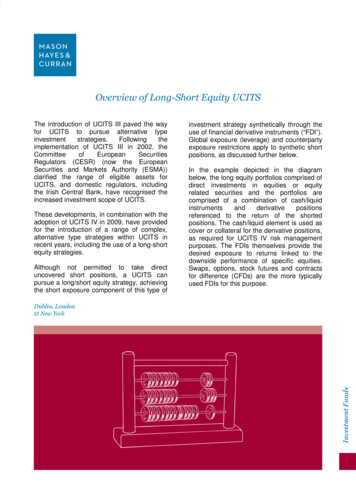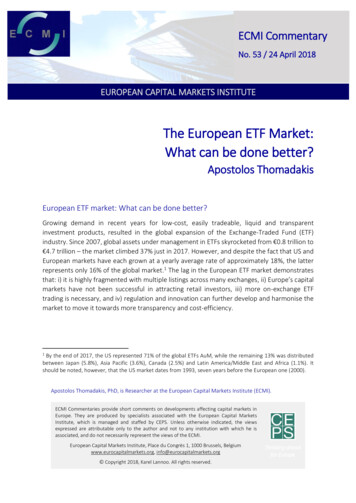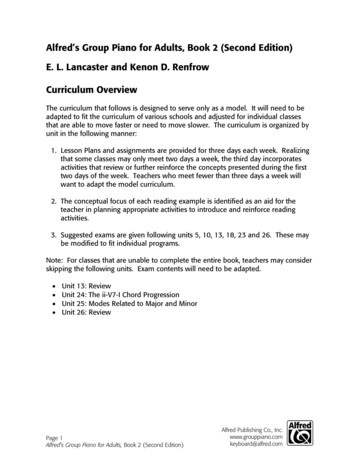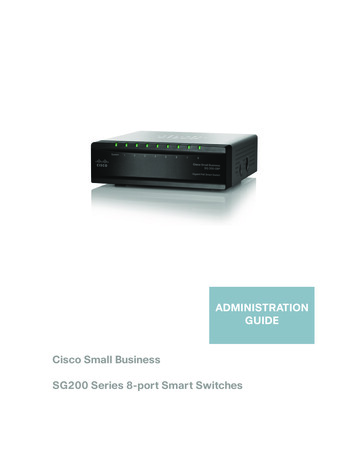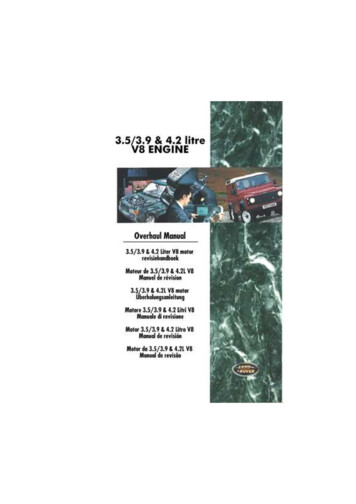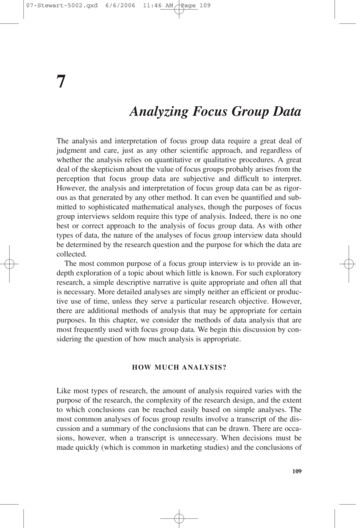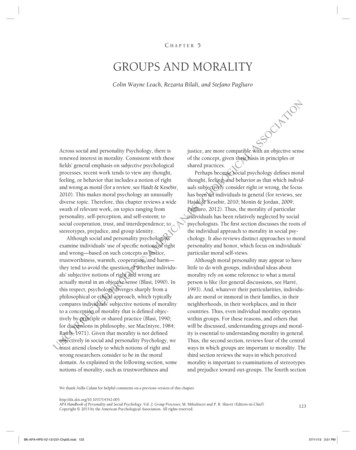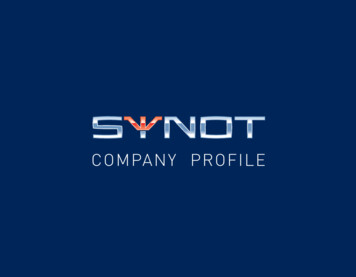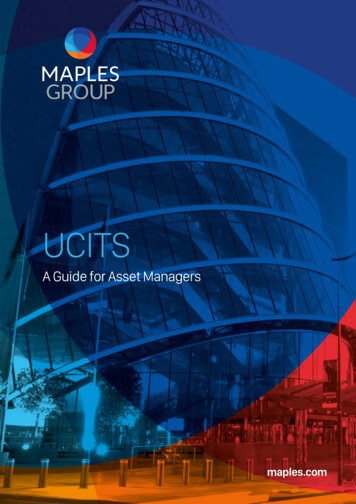
Transcription
UCITSA Guide for Asset Managersmaples.com
OVERVIEWUCITS are open-ended collective investment schemes established andauthorised pursuant to EU law, as implemented in the member states of theEU. Perceived as safe and well regulated investments, once authorised, aUCITS can be marketed and sold to retail investors throughout the EEA. Overthe past 30 years, the UCITS product has become increasingly popular as aliquid, transparent, diversified and robustly regulated investment productwith Ireland at the forefront of UCITS investment fund product development.Ireland is widely recognised as one of the world’sleading international fund centres for domiciling andservicing collective investment schemes. Irish UCITSfunds are regulated by the Central Bank of Ireland(the “Central Bank”) pursuant to the various UCITSDirectives, as implemented into Irish legislation.UCITS today can invest in a diverse range offinancial instruments. This starts with investment in‘transferable securities’ (broadly being listed sharesand bonds) as well as: (i) shares of other regulatedfunds; (ii) cash, cash equivalents and moneymarket instruments; and (iii) financial derivativeinstruments. There is also a facility for investmentof up to 10% in unlisted securities.As the rules for permitted asset classes andgovernance requirements continue to evolve, UCITScontinue to be a popular investment managementproduct. Critically, by using derivatives, UCITS cangenerate leverage and achieve synthetic shortexposure. Accordingly, most alternative investmentstrategies (but not all) can be replicated, to a certainextent, within a UCITS. However, it should be saidthat there are elements of the UCITS regime thatcan restrain this process and add an administrativeburden. These include: (i) asset eligibility rules; (ii)asset diversification rules; (iii) liquidity requirements;(iv) risk and counterparty exposure limits; and (v)operational, compliance and governance rules.These elements are considered in more detail withinthis brochure.
UCITS EUROPEANGROWTHUCITS are and continue to be an appealing product structure for assetmanagers looking to access both European retail and institutionalinvestors and international investors.A UCITS authorised in one member state can benefitfrom a passport regime allowing it, subject tonotification, to be offered in another member state.As reflected in the statistics below, UCITS haveachieved phenomenal growth levels, particularly inIrish UCITS over the last decade. 9.7trillion 736billion262% 1.8trillionin European UCITS1Asset levels inIrish UCITSup 262%21 Statistics as at end December 2017. Source: EFAMA.2 Since June 2008. Statistics as at end December 2017. Source: EFAMA.3 Statistics as at end June 2018. Source: Irish Funds.Inflows in EuropeanUCITS in 2017in Irish UCITS3 18.8%growth in 2017
UCITS IRISHASSET LEVELSIreland is now the strongest growing fund domicile in Europe. Assets inIrish UCITS funds have significantly outgrown its main European rivals(Luxembourg, the UK, France and Germany) over the last ten years.Ireland - Fastest Growing of Largest European Fund 0%0%2012Europe20132014LuxembourgIrelandSource: Irish Funds, June 20182015France2016Germany2017UK2018
KEY FEATURESOF A UCITSLiquidityA UCITS must be able to offer redemptions at least twice a month, i.e. fortnightly.A 10% fund level gate is permitted. Redemption proceeds to be received within14 calendar days/10 business days of the redemption deadline.Asset EligibilityAt least 90% of assets must be in liquid (UCITS eligible) instruments (suchas listed equities, fixed income, money market instruments, regulated fundsand derivatives on eligible assets or financial indices). No direct short-sellingpermitted. Direct exposure to real estate and commodities is not permitted.Asset DiversificationNo single asset can represent more than 10% of the fund’s assets; holdingsof more than 5% cannot in aggregate exceed 40% of the fund’s assets. Thisis known as the “5/10/40” rule. There are certain exceptions for governmentissued securities and for index tracking funds.Borrowing AndLeverage LimitsTemporary borrowing is limited to 10% and not permitted for investmentpurposes. A general leverage limit of 100% is applied (although use of Valueat-Risk (“VaR”) to measure global exposure for more complex strategies givessignificant flexibility in this regard).IndependentService ProvidersIrish based, regulated depositary, administrator and auditor provideindependence in key support and oversight functions.Retail InvestorsNo minimum investment level is applied under UCITS regulation (althoughfunds may fix levels themselves); no investor eligibility criteria is applied.Legal StructuresUCITS can be established as Irish Collective Asset-management Vehicles (“ICAVs”),investment companies, unit trusts and Common Contractual Funds (“CCFs”).Availability as aSegregated UmbrellaUCITS can operate as a standalone fund or as an umbrella fund, with multiplesub-funds with segregation of liability at sub-fund level.Operational,Compliance AndGovernance RulesDetailed operating rules are applied covering, for example, valuations, boardoversight and monitoring, set out in greater detail in Central Bank guidance.Key InvestorInformationDocument ("KIID")The KIID is a simplified product factsheet that must be produced in arigid format. This includes disclosure of an objective risk measurementclassification system (synthetic risk reward indicator), disclosure of maximumongoing charges and past performance data.
They have great strength in handlingcountry registrations and all aspectsof maintaining all regulatory filings. Commercially minded, aware of newdevelopments and very proactive They are outstanding on internationalaspects.CHAMBERS EUROPEHighly knowledgeable, proactive and,above all, pragmatic.regarded by some as being ‘the bestin Dublin’.Exceptional technical knowledge.LEGAL 500Partners and associates are technicallyexcellent and can be relied on forpractical and sound business advice.The team at Maples is outstanding.Maples is one of the key law firmsin Ireland. They’re very commercial,responsive and solutions-orientated.IFLRThe Maples Group is independently ranked first amongst Irish lawfirms in Ireland in terms of total number of funds advised (based on thelatest Monterey Ireland Fund Report, as at 30 June 2020).
DEPOSITARY AND THEMANAGEMENT COMPANYDepositaryManagement CompanyThe entity responsible for holding and safe-keepingthe assets of a UCITS is a depositary. This role ishighly regulated and any entity seeking to fulfil thisrole for Irish UCITS must be located in Ireland, andregulated and supervised by the Central Bank oran Irish branch of an EU regulated entity. A singledepositary is appointed to each UCITS. The corefunctions of a UCITS depositary are oversight,safekeeping and cash monitoring.Each UCITS must appoint a management companyor be structured as a self-managed UCITS. Thecore activities covered by the UCITS managementcompany passport are investment management,administration and marketing. Historically onlyUCITS constituted as a unit trust or CCF appointeda third party management company. UCITSstructured as an investment company or an ICAVwere typically structured as a self-managed UCITS.A depositary to a UCITS is strictly liable for the lossof financial instruments that can be held in custody,unless it can prove that the loss has arisen as aresult of an external event, beyond its reasonablecontrol. In the event of such a loss, the depositaryis required to return identical assets to those lostor a corresponding amount to the UCITS withoutundue delay. This strict liability affords investorsin a UCITS a strong level of protection againstloss. The level of protection for assets that are notfinancial instruments that can be held in custody issignificantly lower.There has been a noticeable trend towards theexternally managed UCITS model, largely as a resultof the increased regulatory burden and substancerequirements being placed on self-managed UCITS.In fact, since the Central Bank introduced its newsubstance and governance requirements in late2015, only 17% of authorised UCITS have beenestablished as self-managed structures. UCITSmanagement company model now prevails.Once authorised, a UCITS management companycan provide services not only to UCITS establishedin its home member state, but also to UCITSestablished in other member states. This providesflexibility for management companies to providecollective portfolio management services crossborder, without being obliged to be established inthe UCITS home member state.
LEVERAGE, USE OFDERIVATIVES ANDCOUNTERPARTIESGlobal ExposureValue at RiskThe Central Bank requires a UCITS to calculate its‘global exposure’ on at least a daily basis througheither of the following methodologies:(i) Commitment Approach; or(ii) Value at Risk.Under the Value at Risk or “VaR” approach,global exposure is measured by the market riskof the UCITS. This means a measurement of themaximum expected loss at a given confidencelevel over a specific period. The ‘market risk’ of aUCITS is not the same as the ‘leverage’ of a UCITS.A UCITS using the VaR approach is therefore notlimited to a global exposure of no more than 100%of its net asset value, as is the case for a UCITSusing the Commitment Approach.Commitment ApproachUnder the Commitment Approach, global exposureis measured by the incremental exposure andleverage generated by the UCITS through the use ofFinancial Derivative Instruments (“FDIs”) (includingany embedded derivatives) which may not exceedthe total of the UCITS net asset value. Throughapplying this approach, the UCITS cannot have globalexposure of in excess of 100% of its net asset value.For UCITS using either absolute VaR or relativeVaR to calculate global exposure, disclosure mustbe made in the offering document disclosing anexpected level of leverage, calculated on the basisof the sum of the notionals method. However, thereis no regulatory maximum level imposed in respectof this disclosure. Stated levels can be high,provided in all cases that the UCITS meets the VaRdisclosure requirements.
Counterparty ExposurePrime brokers may not be engaged by UCITS ina full service manner as would be customary foralternative investment funds. However, most primebrokers offer synthetic prime brokerage services tocomply with UCITS rules. In relation to such primebrokers/derivative counterparties, UCITS apply riskexposure rules, counterparty exposure limits andalso counterparty eligibility criteria, addressingcounterparty credit risk issues.The maximum amount a UCITS may be exposedto a counterparty is 10% of the net asset value ofthe UCITS, depending on the classification of thecounterparty. An EU credit institution amount is 10%;any other regulated counterparty is 5%.Counterparty exposure will be measured basedon the mark-to-market value of the derivatives(subject to certain adjustments). In essence, at apoint in time, if the positions were settled, whatwould the counterparty owe the UCITS in total? Thatamount needs to be less than the relevant 5% or 10%limit. There is a range of means by which a UCITScan operate a derivatives portfolio with a singlecounterparty and manage counterparty exposurewithin the limits. For example, large ‘in the money’positions can be settled and rolled over beforelimits are exceeded – so the counterparty pays itsobligations to the UCITS regularly (for example, bytriggering set buffer levels) and never owes morethan the maximum 5% or 10% at any one time.To reduce the exposure, other tools are alsoavailable. Netting of counterparty exposures ispermitted (where there is a contractual nettingagreement and therefore a single flow ofobligations). Also, exposure can be reduced to theextent that the UCITS receives eligible collateralfrom the counterparty or operates a pledge accountfor cash/ collateral which remains within thedepositary’s custodial network, and is subject to thecontrol and security interest of the counterparty.
DISTRIBUTIONOF UCITSThe Maples Group Global Registration ServicesThe Maples Group’s Global Registration Services (“GRS”) team providesa range of services, including supporting UCITS (domiciled in Irelandand Luxembourg) by providing an integrated global network of expertscoordinated by a dedicated central team who manage and support all legaland regulatory aspects governing the cross border marketing of theseproducts on both a private placement and public offer basis.Combining expert local knowledge with full projectmanagement functionality through a seamlessservice creates a powerful and efficient multijurisdictional solution. In doing so, the GRS teamdelivers tailored solutions through a single point ofcontact, which frees valuable internal resources andgenerates significant added value for our clients.registration business, coupled with our experiencein dealing with a broad range of local services, weprovide the best service to our clients and canproactively identify areas where economies of scalecan be achieved.Our aim is to offer a service that provides efficiency,value and peace of mind so that our services becomesolutions, tailored to the needs of our clients. We offer our clients a range of services addressingregulatory aspects to help optimise funddistribution activities globally. We believe thatby having a dedicated team solely focused onOur core GRS service offering includes: Market Intelligence;Market Entry through the EEA Passport orRestricted Offerings; andMaintenance.For further details please refer to our GRSbrochure on Marketing UCITS and AIF throughthe European Passport.
INDICATIVE LAUNCHTIMETABLE FOR A UCITSIn the context of the establishment and authorisation of an Irish UCITS, wewould generally anticipate a timeline of approximately 10-12 weeks fromthe point at which all parties have been engaged and have commencedwork on the project. Below is a very high level overview of some key steps.Agree terms of initial draftprospectus (promoter andthe Maples Group, withinput signed off from Irishtax advisers, depositary/administrator). Receive draftdepositary/ administrationagreement from Irishadministrator/depositary.Verify the investmentmanager selected hasbeen previously approvedby the Central Bank/fileapplication for investmentmanager approval withthe Central Bank.File initial funddocumentation submissionwith the Central Bank andliaise with proposed directorsregarding online IQ system.Identify target countries ofpassport/registration.WEEK 1WEEK 2WEEK 3WEEK 12Finalise fund documentation,agree with all parties andexecute. Make authorisationfiling with the Central Bank,obtain UCITS authorisation.Initiate UCITS passportapplication and registrationsin other markets. Acceptanceof seed investment.4WEEK 10-11Operational mattersaddressed with accountopening. Hold fund launchboard meeting to appointdirectors and approve funddocumentation. Receiveconfirmation of initial capital from administrator (in fund account).WEEK 8-9Address subsequentCentral Bankcomments ondocumentation.For further details, please refer to our UCITS KIID and PRIIPs KID Production brochure.Agree terms of depositary/administration agreementand investmentmanagement agreement.Initiate KIID production4.WEEK 4-5WEEK 6-7Address initial CentralBank comments ondocumentation. Agreeterm of local payingagent agreements andcountry supplements.
TAX HEADLINE POINTS FOR UCITSTax EfficientNo Irish taxation arises on income or gains at the level of the Irish UCITS fund.No Withholding TaxNo withholding tax on dividend or redemption applies on payments to nonIrish investors.Tax Treaty AccessIrish UCITS funds may be entitled to benefit from the provisions ofIreland's double tax treaties, including the US / Ireland treaty, subject to theprovisions of each treaty and the rules in the relevant treaty partner countryin each case.Vat ExemptionsThe provision of certain standard services to Irish UCITS funds (e.g.investment management, administration, transfer agency, depositary, etc.)are treated as VAT exempt in Ireland. To the extent that the Irish UCITS fundincurs Irish VAT on certain services it receives (e.g. audit and legal fees), itmay recover a portion of this VAT based o n its recovery rate.Stamp Duty andSubscription TaxesNo stamp duty is payable in Ireland on the issue, transfer, repurchase orredemption of shares in an Irish UCITS fund. No subscription taxes arelevied by the Irish tax authorities on the assets of an Irish UCITS fund.Exchange OfInformationIreland is fully compliant with the OECD Global Forum on Transparency andExchange of Information for Tax Purposes. Ireland has implemented boththe US FATCA regime and the OECD common reporting standard (“CRS”).Irish UCITS funds are thus capable of complying with international FATCAand CRS requirements. Provided the Irish UCITS fund complies with itsFATCA obligations, no FATCA withholding should apply on payments fromUS sources.
FREQUENTLY ASKEDQUESTIONSWhat is the most popular structurefor Irish UCITS?The ICAV is by far the most popular choice of vehicle for assetmanagers forming Irish UCITS. For more details on the ICAVstructure, please refer to ICAV - A Guide for Asset Managers.Can a fund redomicile to Irelandunder the UCITS regime?Ireland offers a corporate migration regime supported byspecific legislation as well as regulatory measures supportingunit trust redomiciliations. Funds can migrate from Bermuda,the British Virgin Islands, the Cayman Islands, Guernsey,Jersey and the Isle of Man. Migrating funds can be authorisedas UCITS.Can a UCITS merge with anotherUCITS?Yes. UCITS legislation provides for a specific merger regime forUCITS funds under which Member States must allow for crossborder and domestic mergers in accordance with one or moreof the following merger techniques:(i) Where a UCITS transfers all of its assets and liabilities toanother existing UCITS without going into liquidation;(ii) Where at least two UCITS transfer all their asset andliabilities to a new UCITS which they form without going intoliquidation; and(iii) Where one or more UCITS, which continue to exist untilthe liabilities have been discharged, transfer their net assetsto another sub-fund of the same UCITS, to a new UCITS or toanother existing UCITS.
Are there requirements in relationto the regulatory status of theinvestment manager?Ireland will recognise and approve investment managers who areregulated by an EU supervisory authority (such as the AMF, BaFin)or global equivalents (such as the SEC, NFA or CFTC in the UnitedStates, the SFC in Hong Kong and regulators in other jurisdictions)subject to filing short organisational and background details toensure the integrity of the investment manager together withdetails of the financial resources of the investment manager.Can UCITS apply credit strategies?Yes. Credit strategy managers can invest across the full creditspectrum and use derivatives in order to generate returns. Inparticular, UCITS may invest in various types of asset-backedsecurities (“ABS”) such as mortgage-backed securities.Can UCITS invest in, or gainexposure to, financial indices?Yes. Financial indices, whether or not comprised of eligibleassets, c an be considered eligible financial indices providedthat they comply with the general conditions applicable tofinancial indices, as set out in guidance issued by the CentralBank, which implements the ESMA guidelines on exchangetraded funds and other UCITS i ssues (ESMA/2012/832EN).Can UCITS invest in, or gainexposure to, commodities?Yes, however direct exposure to commodities is not permitted. AUCITS may invest in a financial index (using a derivative, such asa swap) or invest in a structured products known as “structuredfinancial instruments” or “SFIs” which can be classified as atransferable security to gain indirect exposure to commodities.
CONTACTSDubli
Prime brokers may not be engaged by UCITS in a full service manner as would be customary for alternative investment funds. However, most prime brokers offer synthetic prime brokerage services to comply with UCITS rules. In relation to such prime brokers/derivative counterparties, UCITS ap
